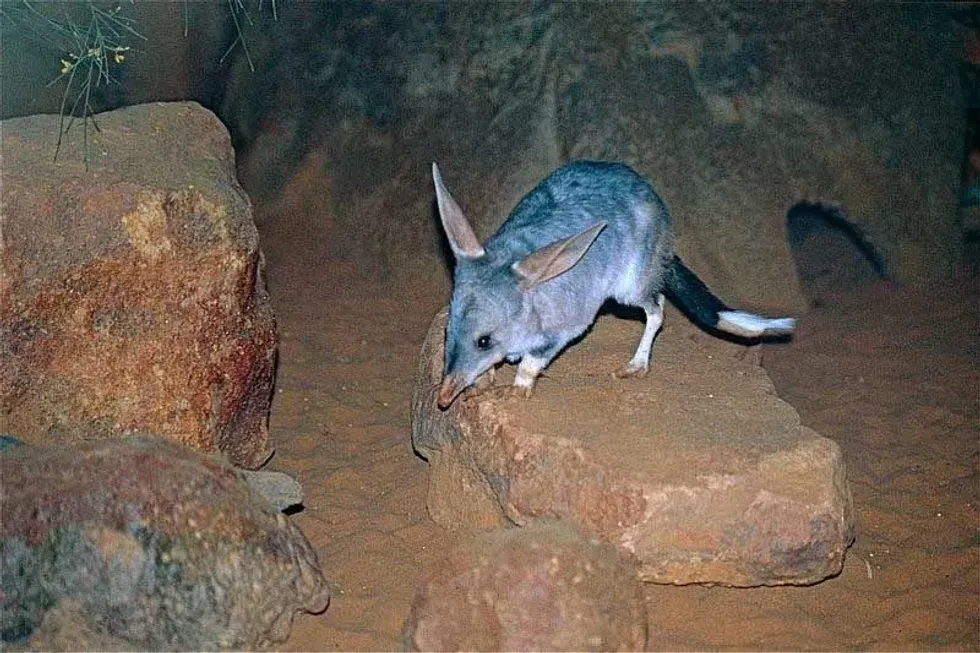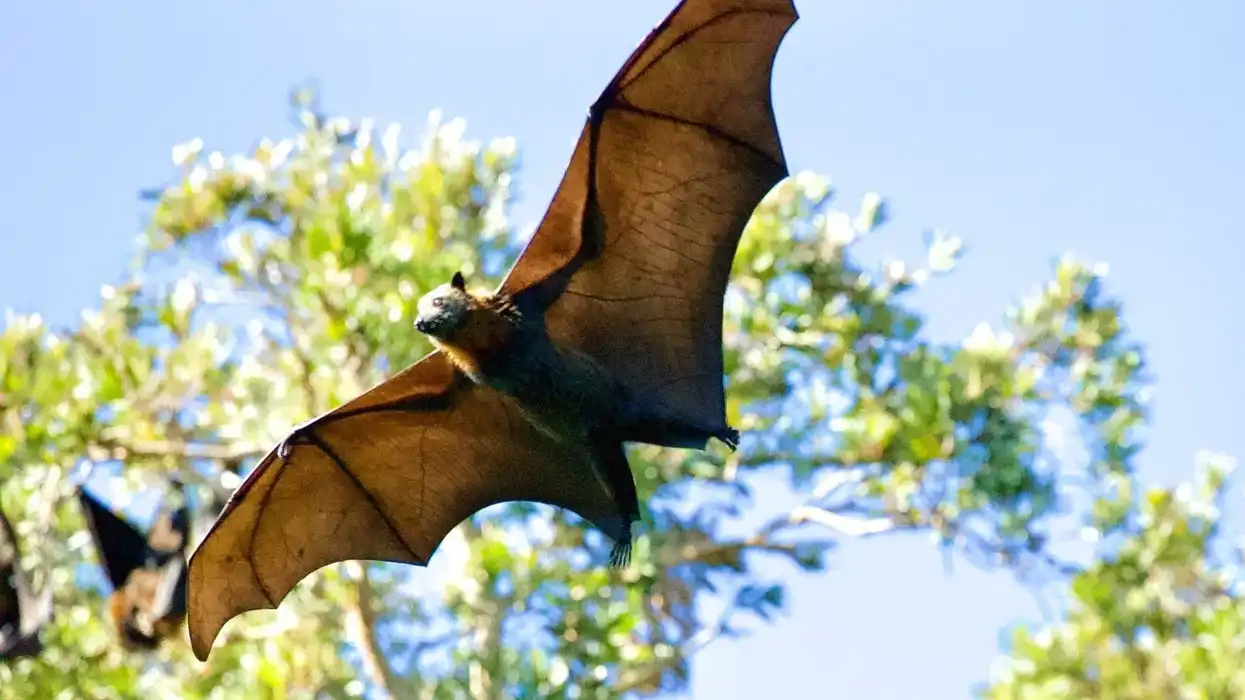The word Bilby means 'long-nosed rat'; it comes from the Aboriginal language, Yuwaalaraay. Also known as Australian Easter Bilby, this animal has long ears and grey fur.
These animals make a habitat in the Great Sandy Deserts, the Tanami Desert of the Northern Territory, Western Australia, and Southwest Queensland. The Bilbies spend most of their time digging several burrows that spiral down, making it difficult for their predators to enter.
The greater Bilby lifespan is six to seven years and reproduces from at six months of age, and the gestation is for 12–14 days. Females are responsible for caring for their young by providing food, and a Joey stays in the female Greater Bilby pouch for 75-80 days.
Although they live in hot areas, they do not need to drink water because they get it from their food. This animals' population is at risk; they were common a hundred years ago but are now considered endangered. Their close relative, Lesser Bilby, Macrotis Leucura, is now completely extinct. Many efforts are underway in Australia to preserve this animal.
If you enjoyed these interesting facts about the Greater Bilby, check out gundi and elephant shrew articles.
Greater Bilby Interesting Facts
What type of animal is a greater Bilby?
Greater Bilby or the Macrotis Lagotis, resembles a rabbit, also popularly known as 'Australia's Easter Bunny', is a marsupial and member of the bandicoot family. They once occupied 70% of Australia’s mainland, however, it is now down to 20% in scattered populations.
What class of animal does a greater Bilby belong to?
The greater Bilby is a mammal with the shortest gestation period as compared to other mammal species. They take care of their young ones by feeding milk produced in the mammary glands of the female Bilbies.
How many greater bilbies are there in the world?
Once commonly seen in Australia's temperate coastal areas, this animal range has been on a steep decline in the last few decades due to severe changes to their habitat. They are now listed as 'vulnerable, only about 600-700 Bilbies are left globally, and intense conservation efforts are underway.
Where does a greater bilby live?
Australian Bilby, Macrotis Lagotis, occupy arid, rocky soils with little ground to semi-arid shrublands, desert sand plains, and woodlands. They are also known to inhabit northern desert areas, spinifex, and tussock grassland regions.
What is a greater bilby's habitat?
European settlement has changed the Greater Bilby habitat. The Australian Bilby populations are now found in the Tanami Desert of the Northern Territory; in the Gibson, Great Sandy Deserts; parts of the Kimberley and Pilbara regions (near Broome) of Western Australia; and in the Mitchell grasslands of southwest Queensland.
Greater Bilby has been reintroduced to various locations in New South Wales, Western Australia, and South Australia, mainly in the predator-free enclosure and protected areas.
Who do greater bilbies live with?
Bilbies mostly live alone or in small groups of two to four digging burrows to protect themselves from the heat and predators.
How long does a greater bilby live?
The Greater Bilby life span is about seven years in the wild. Bilbies typically live for at least six years in captivity, with some specimens reaching up to ten years of age. The Bilbies can breed from six months of age.
How do they reproduce?
A female Bilby can start reproducing from six months of age if conditions are favorable. They can breed all year round, give birth to an average litter size ranging between 1-3 babies, and produce four litters every year.
Australian Bilby's gestation period is for 12 – 14 days, one of the shortest among mammals. Female bilbies have a pouch with an undeveloped fetus until it grows into a juvenile.
Their pouch has a backward-opening, which prevents soil from entering the pouch while digging. These young babies are carried in the pouch for approximately 75 days and become independent within two to three weeks of leaving their mother's pouch.
What is their conservation status?
As classified by IUCN, greater bilbies are vulnerable species. The lesser Bilby, a close relative of the greater Bilby, is now completely extinct.
Just 100 years ago, they were considered to be common. The Bilby habitat is threatened by livestock farming and ranching, invasive non-native and alien species, diseases, feral cats, and foxes.
There is also some competition between rabbits and Bilbies for food. Earnest Bilby conservation efforts are going on for saving these animals with a national recovery plan that includes monitoring populations, breeding in captivity, and re-establishing Bilbies to their historic habitats.
Greater Bilby Fun Facts
What do greater Bilbies look like?
This endangered burrow marsupial is characterized by a pointed nose and silky blue-grey fur. With their huge, pinkish color rabbit ears, it's easy to see the rabbit resemblance.
They are compact in size with a very long black and white tail. As they spend most of their time digging burrows, they have strong forelimbs with long claws to uncover buried food. Truly nocturnal, Bilbies have big ears for sharp hearing and an excellent sense of smell to compensate for their poor eyesight.
How cute are they?
Bilby has bigger ears, a longer tail, and softer, silky fur when compared to bandicoots. Their younger ones look particularly cute as they sit inside their mother's pouch and are very tiny when they are born. The greater Bilby behavior also varies based on the living conditions, and its adaptability has been the key to survival.
How do they communicate?
Bilbies maintain a linear hierarchy among the strongest males. They leave around scent markings to communicate with other Bilbies and signify their dominant status, stating that these burrows are in use.
Females rarely use these scent markings and are solely responsible for their young ones. They rarely indulge in biting if there is a threat, but they display canines and nasal hiss. The sound they make is a mix of a squeak and a grunt.
How big is a greater Bilby?
Bilbies are compact in size. A male Bilby can be the size of a rabbit. They measure 55 cm in body length, and their tail can be as long as 29 cm.
How fast can a greater Bilby run?
Bilbies have a hare-like movement. They move around slowly and carefully in the area closer to their burrows, staying close to the ground to avoid any predators' attention.
How much does a greater Bilby weigh?
The male Bilby can range between 2.2 to 5.3 lb, while the males are known to grow up to 8.2 lb in captivity. Females are smaller than males, and their weight can range between 1.8 to 2.4 lb.
What are their male and female names of the species?
Although the Bilby has many nicknames such as Dalgyte, pinky, and the rabbit-eared bandicoot, there are no specific names for their male and female species. Both female Bilby and male Bilby is called Bilby.
What would you call a baby greater Bilby?
A baby Bilby is known as a joey, the same as babies of other marsupial animals.
What do they eat?
Greater Bilbies spend most of their time digging burrows with their strong front legs, forage for food at night using their long snouts to sense prey. They eat a mix of insects (termites, spiders, Witchetty grubs), fungi, and plant food (bulbs and seeds), most of which they dig up with their strong front legs.
Bilbies get the moisture needed from their food, so they don't need much water.
Do they jump?
Even though these animals have back legs like Kangaroos, they don't jump or hop. Bilbies move in and out of their burrows in search of food or to hide from predators.
Would they make a good pet?
Ideally, Bilbies can be a great replacement for a pet rabbit as it eats vegetation and spends time inside a burrow, more suited to a farmer's lifestyle than a household. However, endangered species are not good to be keep as pets.
Additionally, Australia does not legally allow native animals to be owned as pets.
To protect them, many protected areas and parks are identified to increase Bilby's population. The management members of these protected areas do not own Bilbies but are only the caretakers; Bilbies are often fed bird seeds or cat food.
Did you know...
Easter Bilbies chocolates are sold to popularise the Bilby as a native alternative to the Easter Bunny. Haigh's Chocolates made almost 950,000 chocolate bilbies between 1993 and Easter 2020.
These sales are given as donations to Foundation for Rabbit-Free Australia (RFA), which is involved in environmental work to save indigenous biodiversity from extinction in Australia. The second Sunday in September is also dedicated to National Bilby Day to increase awareness and secure funding for these conservation projects.
Is the greater Bilby endangered?
The greater Bilby, Macrotis Lagotis, is an endangered species, primarily due to human impact and other predators such as feral cats and foxes. The Bilbies have a sharp sense of smell, but their lack of good eyesight often makes them fall prey to their predators.
There is some success to ongoing conservation efforts, particularly at Kanyana Wildlife Rehabilitation Centre, near Perth. Other notable reintroductions have occurred in Western Australia as a part of Western Shield, Australian Wildlife Conservancy's Scotia, and Yookamurra Sanctuaries.
What are the greater Bilby's predators?
Invasive species like feral cats, red foxes, and dingoes are responsible for most Australian Bilby mortality. Some native predators, Queensland Bandy-bandy snake, carpet pythons, wedge-tailed eagles, and monitor lizards, also kill many Bilbies each year.
Some unfavorable incidents were reported as a part of reintroduction efforts in Currawinya National Park in Queensland. Around six Bilbies were released in February 2006 into the sanctuary that is considered feral-free.
Unfortunately, the population in Currawinya was severely affected in July 2012 as feral cats gained access into the secure area when the wire nets became rusted after water pooled around sections of the fencing due to flooding. When the cats were first discovered, no greater Bilbies were found again in Currawinya.
Here at Kidadl, we have carefully created lots of interesting family-friendly animal facts for everyone to discover! Learn more about some other mammals including Chinese hamster, or Nubian ibex.
You can even occupy yourself at home by drawing one on our bilby coloring pages.









